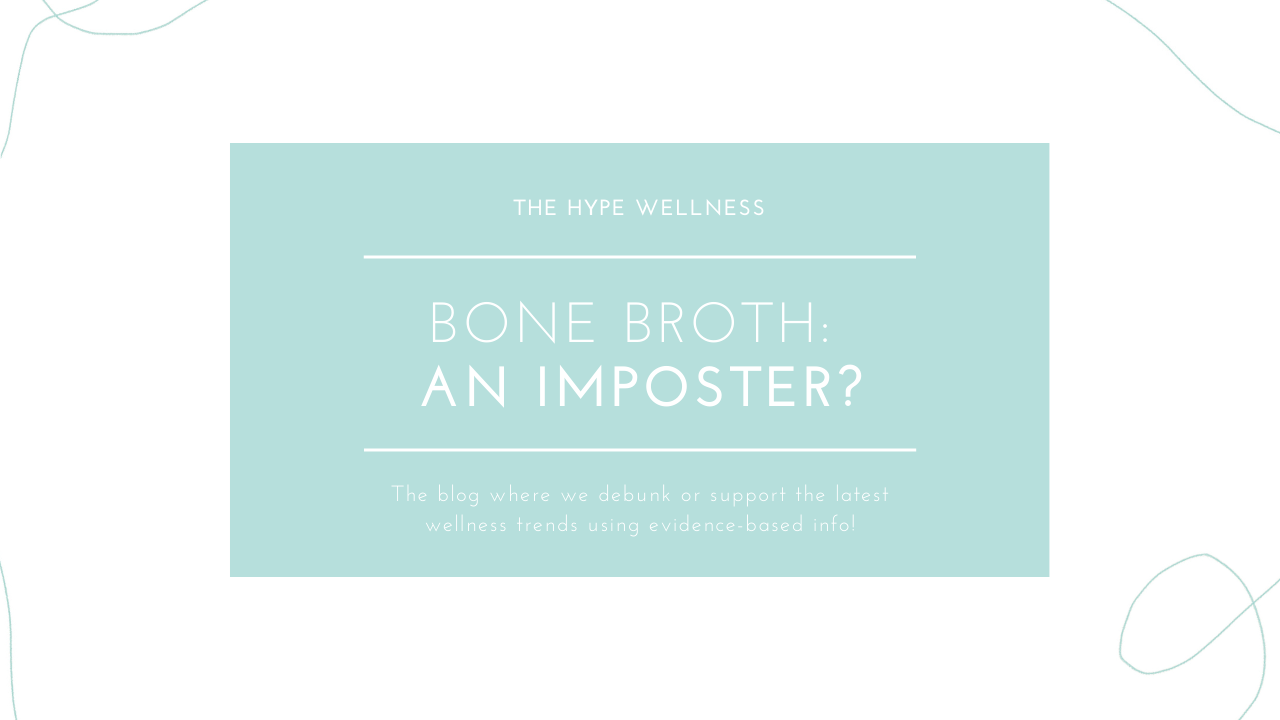Bone Broth: An Imposter?

Bone broth has quickly risen to the top-10 list of nutrition fads. With claims of boosting immunity, detoxing the liver, aiding digestion, relieving arthritis, and having anti-aging properties, it seems logical that it would receive such attention. Countless blog pages, cooking channels, and magazines have jumped on the endorsement-train of bone broth—including New York Times and Women’s Health Magazine. Even some dieticians are recommending the daily consumption of bone broth.
But the fact is, there is no definitive research on the ”benefits” of bone broth. There is, however, research on the dangers of consuming bone broth—but let’s pace ourselves here.
What is bone broth?
Bone broth is a cross between a stock and a traditional broth. By definition, broths are typically made by simmering water with meats, herbs, vegetables, and spices, and on occasion, bones as well. Broths cook for about 45 minutes on the stove, then are strained and seasoned. Stocks are prepared by simmering vegetables, animal bones, and sometimes meat for anywhere between 4 and 6 hours before straining. Bone broth is a little different; roasted bones, sometimes with the meat still attached, and vegetables are simmered for more than 24 hours before being strained and seasoned.
Bone broth is prepared using an acid, typically apple cider vinegar, to leach the desired minerals out of the bone such as calcium, magnesium, as well as the protein, collagen. However, in doing so, large amounts of unwanted metals such as lead can also be leached from the bones—this poses a great biological risk to consumers—especially children.
Nutrient Content
According to the USDA Nutrient Database, an accurate nutrient analysis for bone broth is not available. Understandably so, as the nutritional and mineral content of the broth is dependent on the bones and other ingredients used.
A study published in 2013 showed bone broth to contain 10x more lead than the water used as the base of the broth. Even though the bones originated from organic chickens, their skin and cartilage lent the highest amounts of lead to the end product compared to the other ingredients.
On the other hand, a more recent study noted that the levels of cadmium and lead found in bone broth were relatively low.
Moral of the story? Nutrient levels range depending on the ingredients used, even organic chicken bones contain lead, and generalizable data is not available yet on the nutrient or mineral content of bone broth.
Potential Benefits
Bone broth has taken on a reputation of being a “superfood” and a healer of nearly every body system ranging from the digestive system to the immune system. The paleo-community advises its followers to drink bone broth, “like our ancestors,” for stronger bones, arthritis relief, and younger, and more youthful looking skin.
Research has yet to support any claims relating bone broth to digestive health or other reported health claims. However, studies have supported the role of soup in respiratory healing. A study published in 2000 reported a mild anti-inflammatory response from the consumption of soup that could help to lessen the symptoms of respiratory infections. In this case, the soup being studied was good old-fashioned chicken soup, made with vegetables of course for the added nutrient content. This research showed that though the ingredients added into the soup individually had cytotoxic effects (cell-harming), the soup as a whole was not cytotoxic (not cell-harming)—in fact, consuming chicken and vegetable soup proved to improve the migration of neutrophils to the area of infection in the body. Neutrophils are important immune cells that help to fight off infection; by improving their migratory capacity, we can more easily recover from certain infections—specifically upper respiratory infections.
Final Thoughts
Bone broth isn’t technically a broth, but it’s not a stock either. Its preparation is extensive and could actually lead to the pulling of harmful metals from the bones themselves. Also, reports have yet to support the nutritional claims of this popular delight.
Claims regarding the nutritional content of bone broth should be taken with a grain of salt—preferably, with a shot of tequila and salt! What I’m saying is, bone broth is only as nutritionally competent as it’s ingredients, however, to avoid any possibly harmful components of bone broth, it is much easier to simply take out the bones—and violà, perfectly safe, nutritionally adequate, lead-free vegetable broth! Enjoy!
Comment below and let us know your thoughts about bone broth! Do you have any family-famous recipes that you love and would be willing to share? We would love to hear from you! Thanks for reading.
Resources:
- Monro JA, Leon R, Puri BK. The risk of lead contamination in bone broth diets. Med Hypotheses. 2013 Apr;80(4):389-90.
- Rennard BO, Ertl RF, Gossman GL, Robbins RA, Rennard SI. Chicken soup inhibits neutrophil chemotaxis in vitro. Chest. 2000;118(4):1150-1157.

